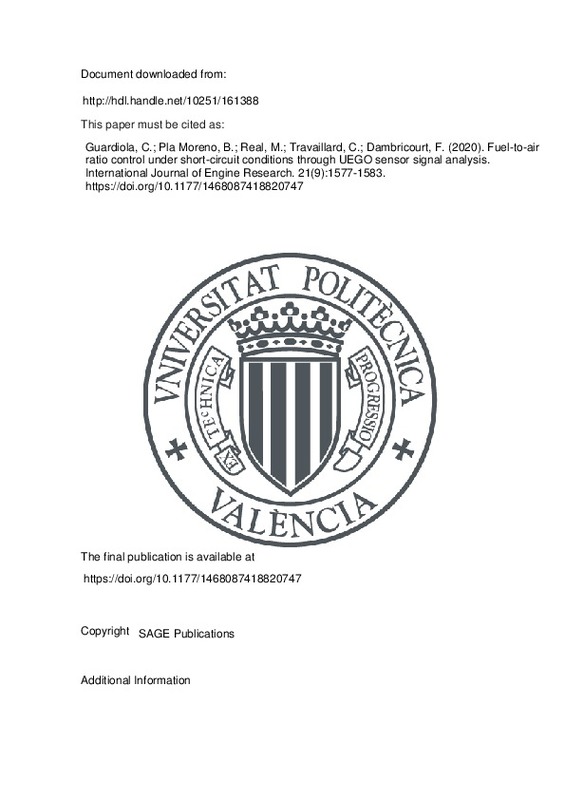JavaScript is disabled for your browser. Some features of this site may not work without it.
Buscar en RiuNet
Listar
Mi cuenta
Estadísticas
Ayuda RiuNet
Admin. UPV
Fuel-to-air ratio control under short-circuit conditions through UEGO sensor signal analysis
Mostrar el registro sencillo del ítem
Ficheros en el ítem
| dc.contributor.author | Guardiola, Carlos
|
es_ES |
| dc.contributor.author | Pla Moreno, Benjamín
|
es_ES |
| dc.contributor.author | Real, Marcelo
|
es_ES |
| dc.contributor.author | TRAVAILLARD, Cyril
|
es_ES |
| dc.contributor.author | Dambricourt, Frederic
|
es_ES |
| dc.date.accessioned | 2021-02-16T04:32:26Z | |
| dc.date.available | 2021-02-16T04:32:26Z | |
| dc.date.issued | 2020 | es_ES |
| dc.identifier.issn | 1468-0874 | es_ES |
| dc.identifier.uri | http://hdl.handle.net/10251/161388 | |
| dc.description.abstract | [EN] The impact of short-circuit pulses on the after-treatment system of a spark-ignited engine must be taken into account to keep the fuel-to-air equivalence ratio within the three-way catalyst window, thereby reducing pollutant emissions. The fuel-to-air equivalence ratio overestimation that suffers the wide-range ¿-sensor upstream three-way catalyst in the presence of short circuit is especially relevant. In this study, a novel approach to deal with the fuel-to-air equivalence ratio control under short-circuit conditions is introduced. Under this scope, this work proposes a strategy for the on-board correction of the aforementioned fuel-to-air equivalence ratio overestimation, by means of the information regarding short-circuit level that provides the frequency content of the ¿-sensor at the engine frequency. Finally, the potential of this approach to minimize pollutant emissions, in particular the NOx penalty arisen as a consequence of running the engine under leaner conditions than expected, is assessed through experimental tests. | es_ES |
| dc.description.sponsorship | The author(s) disclosed receipt of the following financial support for the research, authorship, and/or publication of this article: The authors acknowledge the support of Spanish Ministerio de Economia, Industria y Competitividad through project TRA2016-78717-R | es_ES |
| dc.language | Inglés | es_ES |
| dc.publisher | SAGE Publications | es_ES |
| dc.relation.ispartof | International Journal of Engine Research | es_ES |
| dc.rights | Reserva de todos los derechos | es_ES |
| dc.subject | Short-circuit | es_ES |
| dc.subject | SI engine | es_ES |
| dc.subject | Fuel-to-air ratio control | es_ES |
| dc.subject | Three-way catalyst | es_ES |
| dc.subject | Emissions control | es_ES |
| dc.subject.classification | MAQUINAS Y MOTORES TERMICOS | es_ES |
| dc.title | Fuel-to-air ratio control under short-circuit conditions through UEGO sensor signal analysis | es_ES |
| dc.type | Artículo | es_ES |
| dc.identifier.doi | 10.1177/1468087418820747 | es_ES |
| dc.relation.projectID | info:eu-repo/grantAgreement/MINECO//TRA2016-78717-R/ES/ESTRATEGIAS DE CONTROL BASADAS EN LA INFORMACION CONTEXTUAL DEL VEHICULO PARA LA REDUCCION DEL CONSUMO DE COMBUSTIBLE Y LAS EMISIONES EN CONDICIONES REALES DE CONDUCCION/ | es_ES |
| dc.rights.accessRights | Abierto | es_ES |
| dc.contributor.affiliation | Universitat Politècnica de València. Departamento de Máquinas y Motores Térmicos - Departament de Màquines i Motors Tèrmics | es_ES |
| dc.description.bibliographicCitation | Guardiola, C.; Pla Moreno, B.; Real, M.; Travaillard, C.; Dambricourt, F. (2020). Fuel-to-air ratio control under short-circuit conditions through UEGO sensor signal analysis. International Journal of Engine Research. 21(9):1577-1583. https://doi.org/10.1177/1468087418820747 | es_ES |
| dc.description.accrualMethod | S | es_ES |
| dc.relation.publisherversion | https://doi.org/10.1177/1468087418820747 | es_ES |
| dc.description.upvformatpinicio | 1577 | es_ES |
| dc.description.upvformatpfin | 1583 | es_ES |
| dc.type.version | info:eu-repo/semantics/publishedVersion | es_ES |
| dc.description.volume | 21 | es_ES |
| dc.description.issue | 9 | es_ES |
| dc.relation.pasarela | S\388513 | es_ES |
| dc.contributor.funder | Ministerio de Economía y Competitividad | es_ES |
| dc.description.references | Pagot, A., Duparchy, A., Gautrot, X., Leduc, P., & Monnier, G. (2006). Combustion Approach for Downsizing: the IFP Concept. Oil & Gas Science and Technology, 61(1), 139-153. doi:10.2516/ogst:2006009x | es_ES |
| dc.description.references | Leduc, P., Dubar, B., Ranini, A., & Monnier, G. (2003). Downsizing of Gasoline Engine: an Efficient Way to Reduce CO2 Emissions. Oil & Gas Science and Technology, 58(1), 115-127. doi:10.2516/ogst:2003008 | es_ES |
| dc.description.references | Observer-based air fuel ratio control. (1998). IEEE Control Systems, 18(5), 72-83. doi:10.1109/37.722254 | es_ES |
| dc.description.references | Takiyama, T. (2001). Airâ fuel ratio control system using pulse width and amplitude modulation at transient state. JSAE Review, 22(4), 537-544. doi:10.1016/s0389-4304(01)00135-7 | es_ES |
| dc.description.references | Chen-Fang Chang, Fekete, N. P., Amstutz, A., & Powell, J. D. (1995). Air-fuel ratio control in spark-ignition engines using estimation theory. IEEE Transactions on Control Systems Technology, 3(1), 22-31. doi:10.1109/87.370706 | es_ES |
| dc.description.references | Shafai, E., Roduner, C., & Geering, H. P. (1996). Indirect Adaptive Control of a Three-Way Catalyst. SAE Technical Paper Series. doi:10.4271/961038 | es_ES |
| dc.description.references | Yildiz, Y., Annaswamy, A. M., Yanakiev, D., & Kolmanovsky, I. (2010). Spark ignition engine fuel-to-air ratio control: An adaptive control approach. Control Engineering Practice, 18(12), 1369-1378. doi:10.1016/j.conengprac.2010.06.011 | es_ES |
| dc.description.references | Germann, H., Taglaiferri, S., & Geering, H. P. (1996). Differences in Pre- and Post-Converter Lambda Sensor Characteristics. SAE Technical Paper Series. doi:10.4271/960335 | es_ES |
| dc.description.references | Olsen, D. B., Hutcherson, G. C., Willson, B. D., & Mitchell, C. E. (2002). Development of the Tracer Gas Method for Large Bore Natural Gas Engines—Part I: Method Validation. Journal of Engineering for Gas Turbines and Power, 124(3), 678-685. doi:10.1115/1.1454116 | es_ES |
| dc.description.references | Macian, V., Lujan, J. M., Guardiola, C., & Yuste, P. (2006). DFT-based controller for fuel injection unevenness correction in turbocharged diesel engines. IEEE Transactions on Control Systems Technology, 14(5), 819-827. doi:10.1109/tcst.2006.876924 | es_ES |
| dc.description.references | Macián, V., Galindo, J., Luján, J. M., & Guardiola, C. (2005). Detection and Correction of injection failures in diesel engines on the basis of turbocharger instantaneous speed frequency analysis. Proceedings of the Institution of Mechanical Engineers, Part D: Journal of Automobile Engineering, 219(5), 691-701. doi:10.1243/095440705x28312 | es_ES |







![[Cerrado]](/themes/UPV/images/candado.png)

